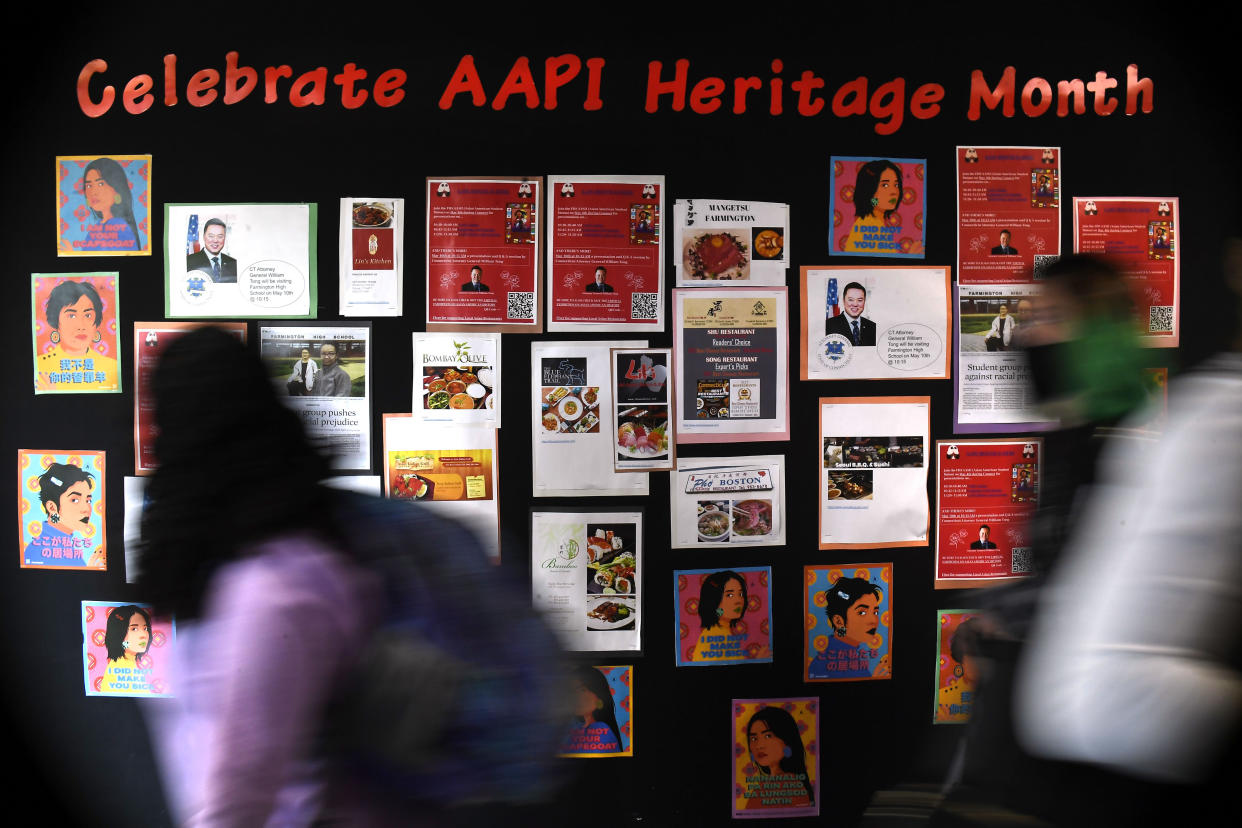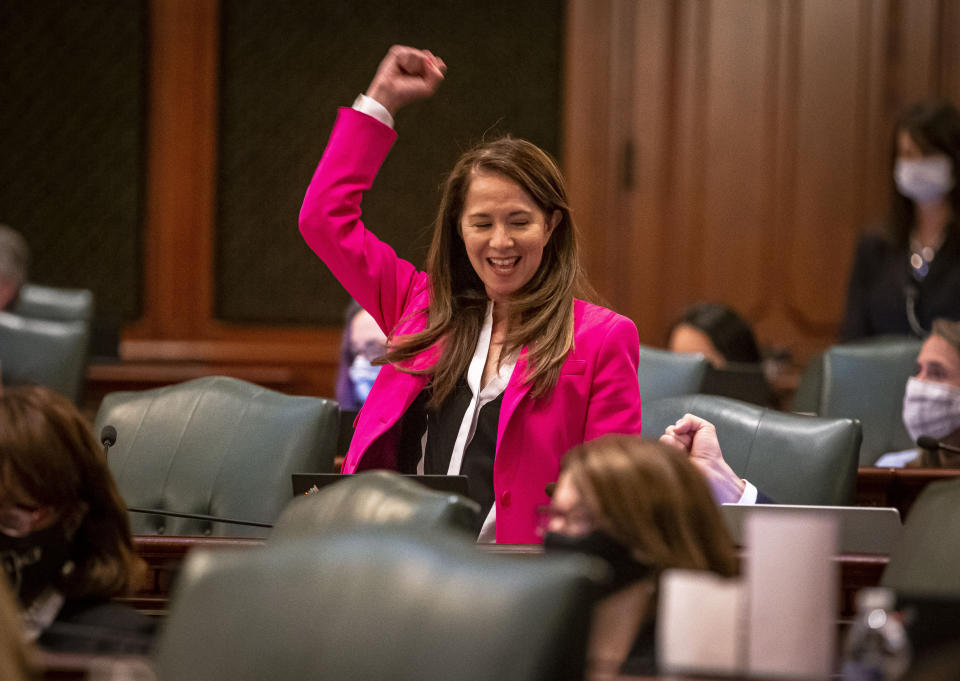How the Pandemic and Anti-Asian Violence Spurred 2 States to Change History Lessons

Students walk past a display for Asian Pacific American Heritage Month at Farmington High School in Farmington, Conn.., on May 10, 2021. Credit - Jessica Hill—AP
When New Jersey Gov. Phil Murphy signed a law requiring public schools to include lessons on the history of Asian Americans and Pacific Islanders, it was a bittersweet moment for Kani Ilangovan.
“I was a child who was one of the only Asian Americans in my school,” says Ilangovan, who was instrumental in getting the law passed, “and it would have been very helpful for me to see how Asian Americans and Pacific Islanders helped contribute to this country, helped build this country.”
Now, Ilangovan feels better knowing that other children—including her own—will learn what she wishes she’d learned about the history of Asian Americans, who make up about 6% of the U.S. population and are the fastest-growing racial or ethnic group in the country.
Asian Americans and Pacific Islanders (AAPI) have long faced racism and violence based on harmful stereotypes, including a recent increase in hate crimes tied to the coronavirus pandemic. That rise in anti-Asian violence spurred Ilangovan to found Make Us Visible New Jersey in March 2021 and to begin advocating for mandatory Asian American history in schools.
"If we teach about Asian Americans, that means that we need to talk about race and racism."
The nationwide effort is bearing fruit, albeit slowly, and at a time when calls to introduce diverse perspectives into history lessons and to more honestly address racism in America face fierce pushback that could clash with efforts like Ilangovan’s.
“If we teach about Asian Americans, that means that we need to talk about race and racism,” says Sohyun An, a professor of social studies education at Kennesaw State University in Georgia, arguing that it’s impossible to discuss the incarceration of Japanese Americans, the Chinese Exclusion Act and the killing of Vincent Chin, for example, without also addressing systemic racism in the U.S.
New Jersey is the second state, after Illinois, to mandate teaching of AAPI history. About 30% of AAPI parents said their child experienced a hate incident at school in the past year, according to a national survey published in November by the advocacy group Stop AAPI Hate. Ilangovan, who grew up in Illinois, and other advocates hope that new school curriculum requirements could change that by raising awareness about anti-Asian stereotypes and racism and by preventing bullying and violence in and out of school.
“There’s so much history that’s unknown that I would love for people to know, and especially for AAPI children to know, and also for their classmates to know because kids pay attention to whose histories are being taught in school,” says Ilangovan. “It teaches them who’s important and not for society, and we’ve felt invisible for so long.”

Concerns of a ‘chilling effect’
Similar legislation is under consideration in other states. In Michigan, Democratic lawmakers introduced a bill this month that would require instruction about AAPI history. Make Us Visible, a group that advocates for the inclusion of AAPI studies in public schools, has members in Connecticut, Pennsylvania, Georgia and Florida, in addition to New Jersey.
As these efforts continue, though, An worries that campaigns against critical race theory will have a “chilling effect” on educators. In New Jersey, in fact, Republican lawmakers who voted in support of the AAPI bill also introduced legislation that would prohibit the “teaching of critical race theory in public schools.”
The bill defines critical race theory as content that teaches that a person is “inherently privileged, racist, sexist, or oppressive, whether consciously or subconsciously” because of their race or gender, or that the United States “is fundamentally or irredeemably racist or sexist.” It also allows for “the impartial instruction on the historical oppression of a particular group of people based on race, ethnicity, class, nationality, religion, or geographic region,” which could include many examples of racism against Asians in the United States.
Read more: Inside the Fight Over What Kids Learn About American History
Unlike K-12 history lessons, though, critical race theory is a graduate-level academic framework that explores how institutions perpetuate racism. K-12 educators across the country have said they are not teaching it, but it has become a controversial, catch-all term among critics, who argue that lessons addressing systemic racism will divide children and make white students feel guilty.
An is not surprised by the simultaneous rise in legislation that seeks to make history education more inclusive and other legislation that would ban critical race theory. As schools strive to become more equitable and anti-racist, she expects pushback from those who would rather maintain the status quo. “When there’s some racial progress, then there’s a backlash,” An says.
She also thinks the anti-critical race theory backlash reflects a fundamental misunderstanding of what it is, as pundits falsely claim that it has become part of K-12 education and will pit students against each other.
An effort to change stereotypes
An recently published a study analyzing the representation of Asian Americans in U.S. history curriculum standards across 50 states. While there are 2.6 million Asian students in K-12 public schools, about 5.4% of all students, An found that Asian Americans and their experiences “are largely invisible in the official storytelling of the United States.”
“When included, Asian Americans are primarily depicted as an oppressed group lacking civic agency or new immigrants with little contribution to the building of the nation,” An concluded. A new curriculum incorporating their nuanced stories could help confront stereotypical perceptions of Asian Americans as “forever foreigners and the model minority” and lead to greater recognition of their experiences and contributions throughout U.S. history, she wrote.
Russell Fan, a senior at Livingston High School in Livingston, N.J., who advocated for the new curriculum law, is frustrated that he first learned about Filipino-American civil rights activist Larry Itliong and Patsy Mink, the first woman of color elected to Congress, on his own. “It was a shame that we could not learn about them in school,” he says.
"It's about time that an Asian of American heritage is viewed as an American."
Asian American students make up about a quarter of the student body at his high school, but Asian American history is a small part of the curriculum, he says. “When you look at what we’ve learned, it’s definitely not proportionate to the student body makeup,” Fan says.
In her own state of Georgia, An isn’t optimistic that legislation promoting Asian American history would pass, even after the killing of eight people, including six Asian-American women, in Atlanta in March 2021 served as a devastating reminder of the long legacy of anti-Asian violence. Georgia Gov. Brian Kemp has said he aims “to protect our students from divisive ideologies like critical race theory.”
Read more: ‘I’ve Never Seen This Level of Fear.’ Why Asian Americans Are Fueling the Rush to Buy Guns
With this in mind, An and others involved in Make Us Visible’s Georgia group have opted to focus more on reaching out to teachers directly to offer professional development and to encourage them to incorporate Asian American history and literature into lesson plans.
That’s how New Jersey high school teacher Sima Kumar approached her language-arts classes well before the new law. When she teaches The Great Gatsby to sophomores, she pairs it with Jhumpa Lahiri’s novel The Namesake, which chronicles the experience of Indian immigrants in the U.S., to explore the theme of the American dream across the two books.
Kumar hopes the law encourages more teachers to plan lessons that include the experience of Asian Americans and recognize their contributions to history and literature.
“It’s about time that an American of Asian heritage is viewed as an American, not questioned [about] their origin or their belongingness in this country. And that sense of belongingness has got to begin at the K-12 level,” Kumar says. “This is when young people are understanding themselves and their world and their history, and their sense of place.”
